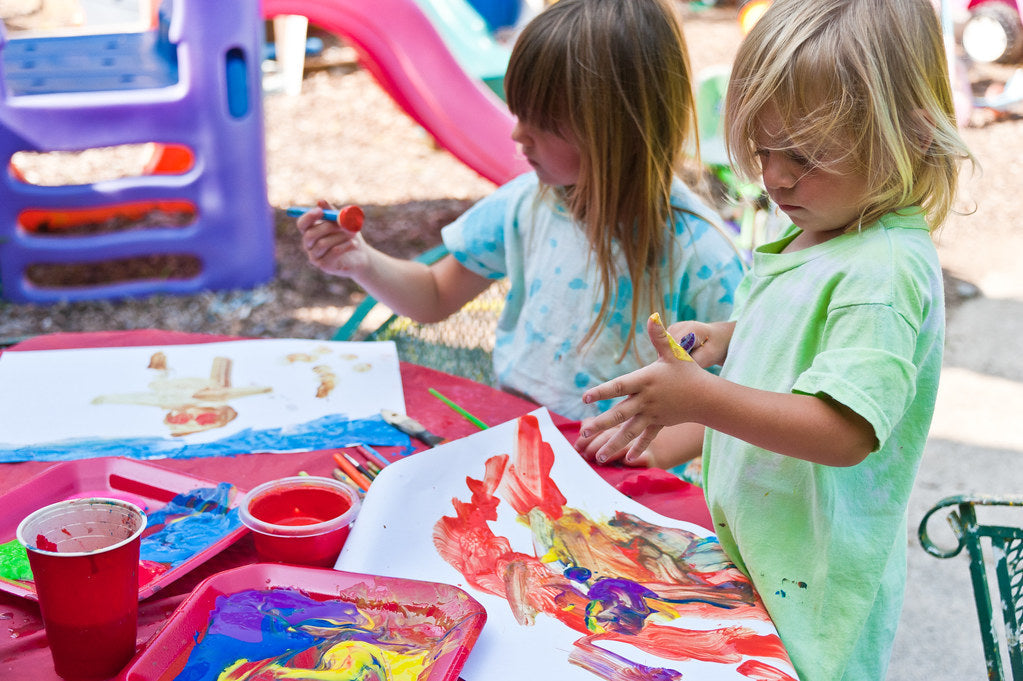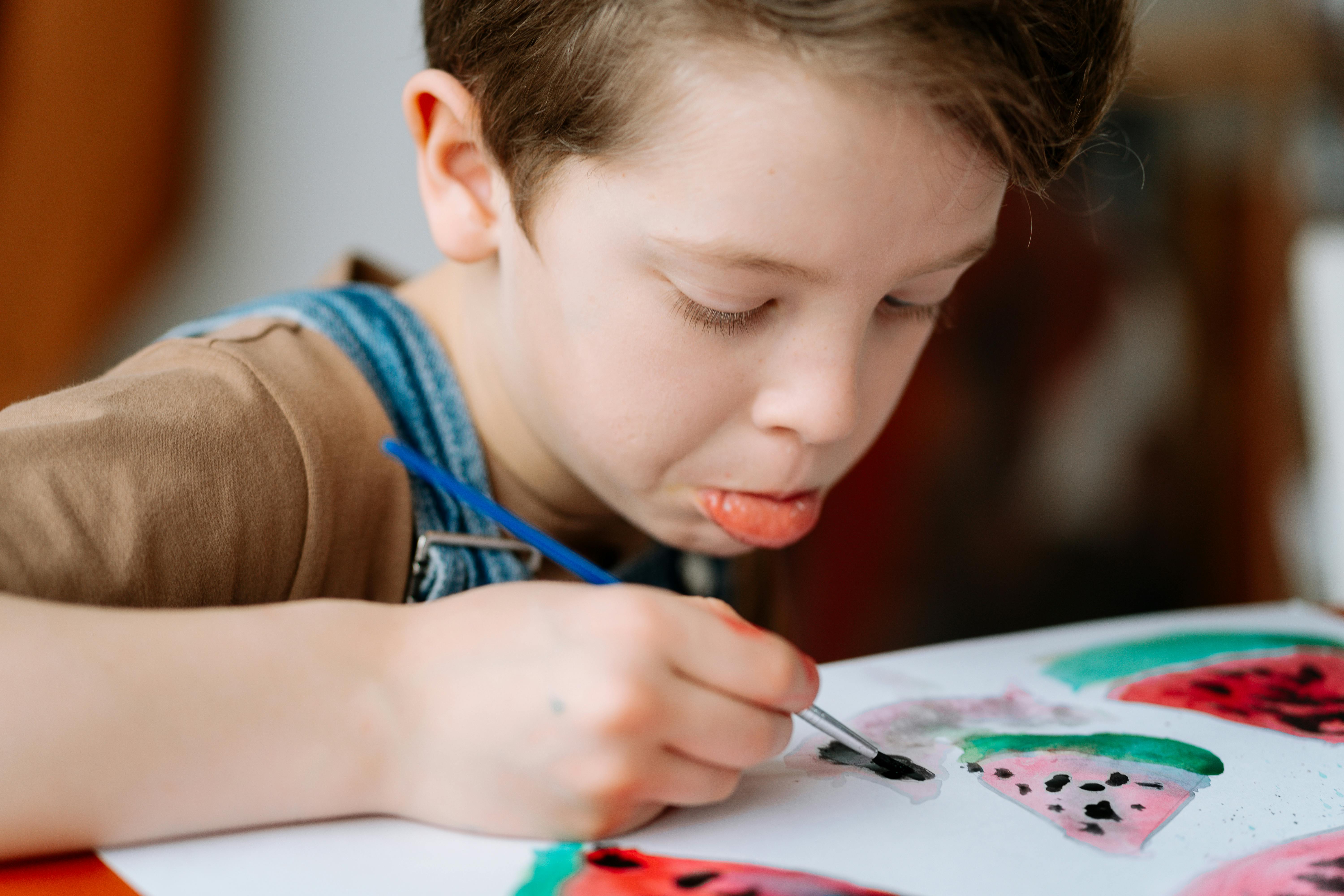Art For Kids Who Hate Being Messy
Do you hesitate to start art projects with your kid because of the mess they’ll make? Or do you have a child who hates the feeling of getting their hands dirty?
There IS a way for your child to express themselves in the way that they feel most comfortable, and it doesn’t have to include messy paints, wet clay, or glitter that seems to cover every surface. It just takes a little pre-planning to find the right no-mess art for kids.

Understand Your Child’s Preferences
Is it that your child doesn’t like art? Or maybe certain types of art are not their thing. Some kids don’t like the smell of finger paint. Maybe they don’t like the way chalk pastels makes their hands feel. Some neurodivergent children dislike certain textures. Perhaps they don’t like getting paint under their fingernails. Or maybe there’s something else entirely.
Be curious about why your child doesn’t like the mess. Try asking your child a few questions about how they experience art.
- What kinds of art projects do you like?
- What kinds of art projects do you dislike?
- Why do you like/dislike them?
- What kinds of supplies do you like?
- Are there any kinds of art you’d like to try, like photography, collages, or music?
Let their answers guide you towards introducing your child to a different type of art, one that doesn’t involve the textures, supplies, or mess that makes them squirm.
No-Mess Art for Kids
It’s also important to remember that “art” is broad and inclusive. There are so many different mediums and another one might suit your child’s likes and dislikes better. Even if your child doesn’t like creating with papier mache, they can certainly still learn to appreciate art, and gain all the benefits of being an art lover, including visual literacy, knowledge of history, and more.
- Needlecrafts, like needle point, cross stitch, sewing, embroidery, quilting, crochet, and knitting
- Creating outdoor mandalas with natural materials like rocks, leaves, and feathers
- Sun prints
- Jewelry making, like beading and polymer clay
- Papercraft, like collages, 3d paper sculptures, and origami
- Water painting
- Sculpting with pipe cleaners and air-dry clay
- Digital art lessons from the Insiders Club
- Drawing with colored pencils, blending sticks, ink pens, markers, crayons, dot markers, watercolor pencils, and paint pens
- Sticker books
- Weaving
- Dance
- Photography
- Art journaling
- Singing and playing instruments
- Creative writing
- Reading books about art
When Things DO Get Messy
As your child’s skills and interest in art grows, they may discover that they actually do like some messy mediums! Always gently encourage your child to try new art projects to discover what they like and give them space to change their mind. Remember, the most important thing is to have fun and grow in their education!

Protect Surfaces
If your child is worried about getting messy, have a designated apron or art shirt available for them to use. Mediums like acrylic paint become permanent on clothing, carpet, and furniture if not cleaned up while wet. A little planning will minimize the mess and make clean-up easier. Insist that your kids ALWAYS wear old shirts over their clothing, cover your work surface and floor, and attend to spills immediately.
For your table and floor, old shower curtains, sheets, and tablecloths work well. If you don’t have any, they are often found very cheaply in thrift stores. This way, you are giving an item a second life and if they become too stained or have holes in them, it really doesn’t matter.
Newspaper isn’t a recommended table covering because the newsprint will rub off on kids’ hands and artwork. The heavy brown paper that is often used as a packing material in boxes you receive is another great option.
Of course, Outside the Box Creation subscribers are always encouraged to cover their work surfaces with the brown paper in the box, which doubles as packing material. When the project is done, the paper can be reused or simply be folded up with all the mess inside and discarded.
Recycle and Reuse
We’re all for using recycled and sustainable supplies as much as possible and for making clean-up as easy as possible. If your mess-averse child is worried about things getting unwieldy in their art space, no need to run out and buy palettes, paint cups, or a paint brush cleaning station.
You can use what you already have. For instance, you can use the Styrofoam trays that vegetables come packaged in as paint-mixing trays or palettes. These would have just ended up in a landfill, so if we can repurpose them, that’s great. Then, when the art project is completed, they can be cleaned and kept, or cleaned and recycled.
Managing Paint and Glue
If your child doesn’t like getting their hands dirty, you can solve that problem a few different ways. It helps to agree before the start of the project how you want to dispense paint and glue. Some possible solutions may include:
- Adults help by dispensing paint and glue.
- Set down an art-only table cloth or Kraft paper to catch any drips.
- Use glue sticks instead of runny glue.
- Your child can use a paint brush or Q-tip to place glue exactly where they want it.
- Paint with dabbers, paint pens, brushes, or another implement.
Create a Designated Drying Space
The last really important part of planning for a project is where completed projects go to dry. For art projects that require time to dry out or cure – like paint, glue, or air-dry clay – pick a spot where the art will be safe and you will be safe from the art!
In colder months, don’t forget that when furnaces kick on, there is often a current of air that can cause paper to be blown and flipped over. Choose surfaces that are out of the way and aren’t in front of an open window or heating vent.
Pro-tip: Keep art projects off the floor. It might seem like a good idea because it gives you a large, flat space away from the table. However, you might have a pet who could step in it, and track paint across the house. You might accidentally overlook it and step on it yourself. Your child might step on it, slip, and fall.

Setting Boundaries on Messy Creativity
There’s a difference between the creative mess that happens while engaging in art making and just making a mess. Less mess typically occurs when kids are actively engaged in an art project and concentrating, as opposed to when they are done and have extra time, or not as interested in the actual project and they begin goofing around. The goof zone is where many messy accidents happen!
It doesn’t have to be an all or nothing proposition. These boundaries can be as simple and clear. For example, you may decide that your child can paint with acrylics using brushes and other tools, but cannot fling or splatter paint.
Or maybe you don’t want kids using their fingers in the paint (although there are merits to letting kids experience the materials tactilely). If you do let kids get their fingers in the paint, there needs to be a clear and simple process for cleaning hands before they touch something else (or each other).
Cleaning Up is Part of the Artistic Process
Just like washing dishes is part of making dinner, cleaning up after an art project is part of the artistic process. Kids can and should clean up after themselves.
It’s important to plan and communicate to kids ahead of time, what the process for cleaning up will be. If you don’t have a sink in the area you’re doing art, then an adult can carry everything to the sink and then the kids clean their palettes, rinsing cups, paint brushes, sponges, and hands.
This is also the time where you would say: When you’re done, the adult will fold up your table covering with the mess inside and dispose of it. Your job is to go wash your hands immediately and then use the designated sponge or rag to wipe off all of the surfaces.

It’s important to remember that creativity can get messy and it’s part of the journey. We need to let kids make enough mess to express themselves, and balance that with keeping our homes, belongings, and clothes clean. Giving your child the responsibility of helping to clean up is an important part of their art education.

